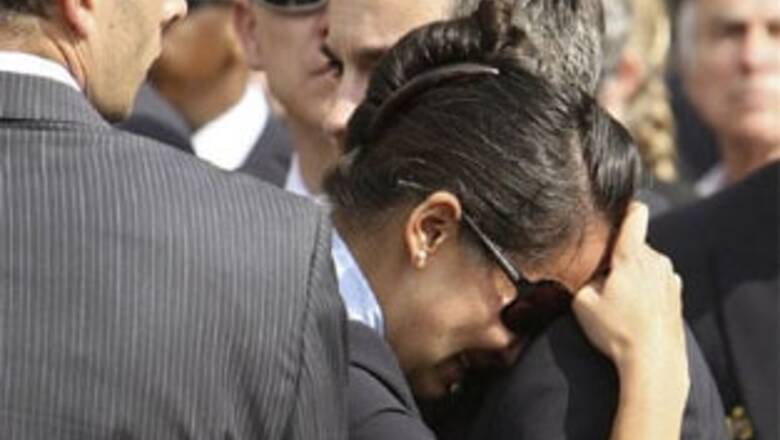
views
Fernando de Noronha: Search crews flying over the Atlantic found debris from a crashed Air France jet spread over more than 55 miles (90 km) of ocean on Wednesday, reinforcing the possibility it broke up in the air.
Brazilian Defense Minister Nelson Jobim said the existence of large fuel stains in the water likely ruled out an explosion, undercutting speculation about a bomb attack.
"The existence of oil stains could exclude the possibility of a fire or explosion," he said at a news conference in Brasilia.
"If we have oil stains, it means it wasn't burned." Experts said extreme turbulence or decompression during stormy weather may have caused the Airbus A330, which took off from Rio de Janeiro bound for Paris on Sunday night, to splinter over the ocean with 228 people on board.
Two Brazilian navy ships arrived in the crash area, about 685 miles (1,100 km) northeast of Brazil's coast, but had not yet retrieved any debris by nightfall.
French officials said they may never discover why the plane went down as the flight data and voice recorders may be lost at the bottom of the ocean.
Air force pilots searching the area have reported no signs of survivors. Officials said recovering bodies may be extremely difficult.
"As well as bodies sinking, you also have problems along the coast of Pernambuco (state) that you know about," Jobim said in reference to sharks.
He added bodies could take several days to float to the surface.
Newly spotted traces of the plane included a 12-mile (20-km) fuel stain and various objects spread across a 3-mile (5-km) area, including one metallic object 23 feet (7 metres) in diameter.
The Air France plane sent no mayday signals before crashing, only automatic messages showing electrical faults and a loss of pressure shortly after it entered stormy weather.
PAGE_BREAK
Total destruction
"I continue to think violent turbulence caused structural damage to the plane," said Jose Carlos Pereira, former head of Brazil's airport authority Infraero.
"Its fall was localized but destruction was total," Pereira told Reuters.
Aviation trade publications focused on warnings in recent months issued by U.S. and European regulators about electronic systems on A330s and A340s that could throw planes into sharp dives.
The directives covered ADIRUs -- air data inertial reference units -- that feed crucial information to the cockpit to help fly planes. With officials struggling to explain how a modern aircraft could have crashed in stormy weather that is routine on the transatlantic route, there was speculation a bomb could have caused the worst crash in Air France's 75-year history.
The airline said on Wednesday it had received an anonymous telephone warning that a bomb was on a flight leaving Buenos Aires on May 27, four days before the crash. A spokesman said the plane was checked, no bomb was found and the aircraft left an hour and a half late. He added that such alerts were relatively common.
Mini Submarine pressed into service
France is dispatching a mini-submarine that can explore to a depth of 19,680 feet (6,000 metres) and will try to locate the Airbus' flight data and voice recorders, which could shed light on the crash.
The recorders are designed to send homing signals for up to 30 days when they hit water, but there is no guarantee they even survived the impact with the sea, said Paul Louis Arslanian, head of France's air accident investigation agency. Given a broken seabed and depths of up to about 2 miles (3 km), finding flight recorders will be very difficult.
PAGE_BREAK
"I am not totally optimistic. We cannot rule out that we will not find the flight recorders," Arslanian said. Brazil will gather aircraft debris on Fernando de Noronha, a sparsely populated volcanic archipelago and nature reserve off its northeastern coast.
It has mobilized 11 air force planes, four navy vessels with divers and a tanker for the retrieval operation that Jobim said was being carried out in a 120-mile (193-km) radius.
An air force plane equipped with a radar and infrared sensor continued the search throughout the night.
Jorge Amaral, a Brazilian air force colonel, said the long strip of metal found on Wednesday was the biggest piece that search crews had seen so far. "It could be part of the fuselage or the tail," he told reporters.
The French investigation will have its first report ready by the end of the month, and will be led by Alain Bouillard, who took charge of the investigation into the crash of an Air France Concorde in 2000.
France held an ecumenical religious ceremony for relatives and friends of those on the plane at Notre Dame Cathedral in Paris on Wednesday, attended by President Nicolas Sarkozy.
In Rio de Janeiro, Air France released a list of Brazilian passengers on board, excluding a few names by request of family members. A memorial mass will be held there on Thursday.




















Comments
0 comment